Header by Rory Midhani
Hello jellybeans! Have you all seen Hidden Figures yet? I hope so, because it is fantastic. Truly the best movie I’ve ever seen about women in STEM. It’s important, it’s inspiring, and it’s beautiful and triumphant. In case you missed it, here’s my favorite trailer for the movie:
I went with my girlfriend on opening night and we were blown away — and hungry for more details on how much of it was actually true. Luckily, there’s plenty of data available on that front, because Hidden Figures is based on a recently released non-fiction book by Margot Lee Shetterly, Hidden Figures: The American Dream and the Untold Story of the Black Women Mathematicians Who Helped Win the Space Race. I found the book to be a little scattered at first (understandable, considering its aim to cover the careers of several dozen women across multiple decades), but it really pulls together if you stick it out past the first few chapters. It’s worth it. The stories are incredible.
So! Let’s take a look together and see which parts of the film were fact, and which parts were beautiful, exquisite, powerful fiction.
FACT OR FICTION: John Glenn said “get the girl to check the numbers,” specifically requesting that Katherine Goble check the math on the trajectories before he boarded the Mercury capsule Friendship 7.
Fact. “Get the girl to check the numbers” is a direct quote from John Glenn, which Katherine overheard from her desk in building 1244 when the phone call to the engineer came in. Unlike the movie, Glenn didn’t expound on the request by adding Katherine’s name — whether because he didn’t know it, didn’t remember it, or didn’t need to — but it was obvious to everyone who he meant.
Writes Margot Lee Shetterly,
Spaceship-flying computers might be the future, but it didn’t mean John Glenn had to trust them. He did, however, trust the brainy fellas who controlled the computers. And the brainy fellas who controlled the computers trusted their computer, Katherine Johnson. It was as simple as eight-grade math; by the transitive property of equality, therefore, John Glenn trusted Katherine Johnson. The message got through to John Mayer or Ted Skopinski, who relayed it to Al Hamer or Alton Mayo, who delivered it to the person it was intended for.
“Get the girl to check the numbers,” said the astronaut. If she says the numbers are good, he told them, I’m ready to go.
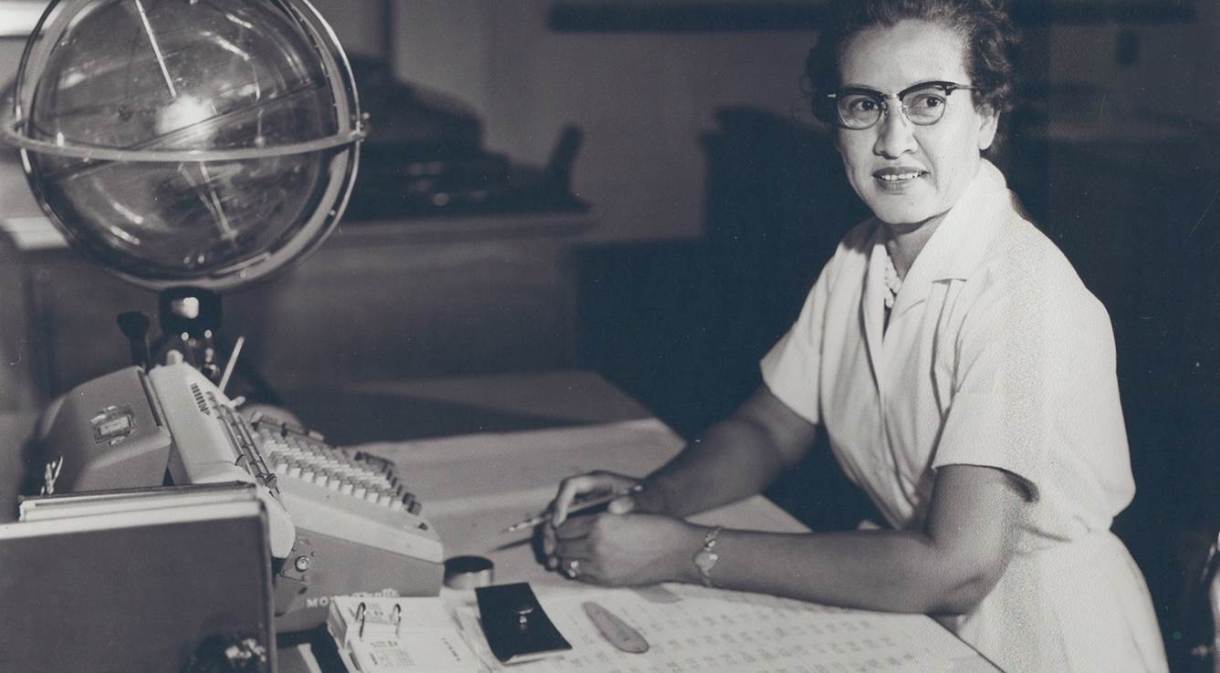
Katherine Goble Johnson.
FACT OR FICTION: Al Harrison took a sledgehammer to the “colored girls” restroom sign, desegregating Langley’s campus.
Fiction. Al Harrison was not a real person, but a fictionalized composite of three NASA directors at Langley during the time. (The writer couldn’t get the rights to the guy he initially wanted.) There is no record of any of them ever personally taking down restroom signs; however, Miriam Mann from West Computing did take down the cafeteria sign.
Writes Shetterly,
It was Miriam Mann who finally decided it was too much to take. ‘There’s my sign for today,’ she would say upon entering the cafeteria, spying the placard designating their table in the back of the room. Not even five feet tall, her feet just grazing the floor when she sat down, Miriam Mann had a personality as outsized as she was tiny. The West Computers watched their colleague remove the sign and banish it to the recesses of her purse, her small act of defiance inspiring both anxiety and a sense of empowerment. The ritual played itself out with absurd regularity. The sign, placed by an unseen hand, made the unspoken rules of the cafeteria explicit. When Miriam snatched the sign, it took its leave for a few days, perhaps a week, maybe longer, before it was replaced with an identical twin, the letters of the new sign just as blankly menacing as its predecessor’s.
At some point during the war, the COLORED COMPUTERS sign disappeared into Miriam Mann’s purse and never came back. The separate office remained, as did the segregated bathrooms, but in the Battle of the West Area Cafeteria, the unseen hand had been forced to concede victory to its petite but relentless adversary.
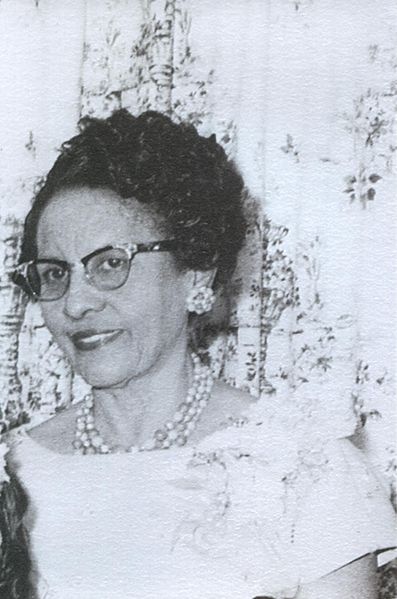
Miriam Mann. Via NASA.
FACT OR FICTION: Katherine, Mary Jackson and Dorothy Vaughn were an inseparable trio, playing bridge together, carpooling to work together, and even sitting together at church.
Fiction. Though the women shared camaraderie and did work in West Computing together (Dorothy beginning in 1943, Mary in 1951, and Katherine in 1953), Katherine’s daily commute etc. was actually made with Eunice Smith.
Per Shetterly,
Eunice Smith lived three blocks down, and Katherine delighted in learning that her soror, neighbor, and fellow worshipper was also a nine-year West Computing veteran. In the early days of June 1953, when Eunice Smith drove over to Katherine’s house to pick her up for work, the two women started a routine that would persist for the next three decades. … Eunice Smith was Katherine’s steadfast companion and confidante. The two of them spent more time together than many married couples, commuting back and forth to work each day, serving together as officers of the Newport News chapter of their sorority, AKA, taking time off from work to root for their teams in the yearly Central Intercollegiate Athletic Association (CIAA) basketball tournament for black colleges. They never missed Sunday service at Carver Memorial Presbyterian Church, and one night a week when they left Langley they headed over to Carver for choir practice.
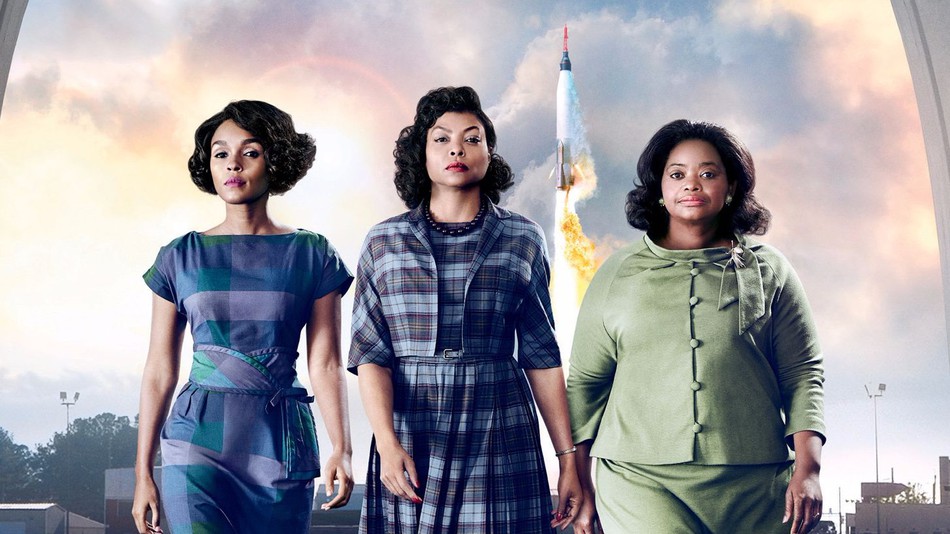
Janelle Monáe, Taraji P. Henson and Octavia Spencer play Mary Jackson, Katherine Johnson and Dorothy Vaughn, respectively. Via 20th Century Fox.
FACT OR FICTION: Katherine used Euler’s method to determine the rocket’s trajectory for the Mercury-Atlas 6 mission.
Fact. The Hidden Figures script was vetted by NASA historians who ensured all of the math was accurate. Katherine used Euler’s method along with many other equations, which Shetterly describes,
Sitting in the emptier office, she plunged into the analysis, although the pesky laws of physics turned an afternoon of rote celestial tennis practice into a forces free-for-all. Earth’s gravity exerted its force on the satellite and had to be accounted for in the trajectory’s system of equations. Earth’s oblateness — the fact that it was not perfectly spherical but slightly squat, like a mandarin orange — needed to be specified, as did the speed of the planet’s rotation. Even if the capsule were to shoot off into the air directly overhead and come back down in the same straight line, it would land in a different spot, because Earth had moved.
‘In the recovery of an artificial earth satellite it is necessary to bring the satellite over a preselected point above the earth from which the reentry is to be initiated,’ she wrote. Equation 3 described the satellite’s velocity. Equation 19 fixed the longitude position of the satellite at time T. Equation A3 accounted for errors in longitude. Equation A8 adjusted for Earth’s west-to-east rotation and oblation. She conferred with Ted Skopinski, consulted her textbooks, and did her own plotting. Over the months of 1959, the thirty-four-page end product took shape: twenty-two principal equations, nine error equations, two launch case studies, three reference texts (Including Forest Ray Moulton’s 1914 book), two tables with sample calculations, and three pages of charts.
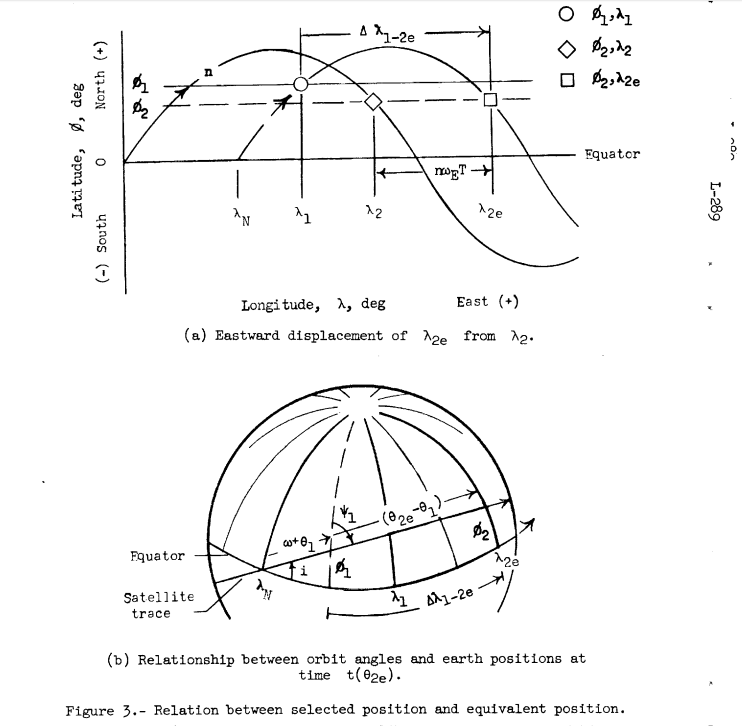
Katherine’s full technical report (“Determination of Azimuth Angle at Burnout for Placing a Satellite Over a Selected Earth Position”) is available on NASA’s website, if you want to check out the math.
FACT OR FICTION: Katherine had to run half a mile across campus to go to the bathroom.
Fiction, though just barely. This activity did happen, but the scene in the movie was based on an experience Mary Jackson had. Katherine actually ignored the rules and used the women’s bathroom in her building.
Shetterly:
From the very beginning, Katherine felt completely at home at Langley. Nothing about the culture of the laboratory or her new office rattled her — not even the persistent racial segregation. At the beginning, in fact, she didn’t even realize the bathrooms were segregated. Not every building had a Colored bathroom, a fact that Mary Jackson had discovered so painfully during her rotation on the East Side. Though bathrooms for the black employees were clearly marked, most of the bathrooms — the ones implicitly designated for white employees — were unmarked. As far as Katherine was concerned, there was no reason why she shouldn’t use those as well. it would be a couple of years before she was confronted with the whole rigmarole of separate bathrooms. By then, she simply refused to change her habits — refused to so much as enter the Colored bathrooms. And that was that. No one ever said another word to her about it.
What a badass.
Notes From A Queer Engineer is a recurring column with an expected periodicity of 14 days. The subject matter may not be explicitly queer, but the industrial engineer writing it sure is. This is a peek at the notes she’s been doodling in the margins.


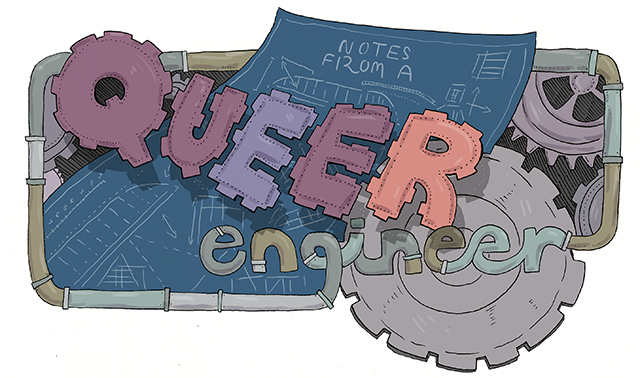

This is awesome, thank you for putting it together! I really wanted to know all of this!
Hooray!

I’m picking up my sister’s copy of the book from her tonight, which I intend to devour over the weekend, and then I have plans with some friends to go see the movie Sunday night, so after THAT I will come back here and read this article!
EXCELLENT, I look forward to hearing your thoughts, @arvan12.
this is amazing fact checking! thanks laura!! i really want to get my hand in that book–there’s also a young reader’s version of the boom that came out almost at the same time that i really want to buy for friend’s children!
I’m so glad that this exists in a young reader’s version! It’s awesome that some kids are going to grow up always having known about this history.
I haven’t seen the movie yet and I’m glad to have read this piece beforehand.
How convenient that a real woman of colour, Miriam Mann, took action (at personal risk, no doubt) to desegregate her work space, but in the movie a fictional white man is given credit. (Stonewall anyone?) There is something so cowardly about the way films about black historical figures always have to add a sympathetic white character and often give them credit for a black person’s work.
Ohhhh. Yeah personally I would have been just as stoked, for instance, to see the real fact of Katherine ignoring the rules and walking right into the women’s restroom in her new building…
I should have added that my ‘cowardly’ comment explicitly refers to white supremacist Hollywood standards and not POC writers, directors etc who are left feeling pressured to either cater to those standards or not have their work produced at all.
Yeah, I don’t love that. I understand that you can’t have a movie with 300 characters in it, but I feel like Miriam Mann’s story could have been really powerful on screen.
Thank you for this, I really great to see the true story behind it. Now to see the move.
You’re welcome! Enjoy the movie!
yessssssss. thank you Laura. I saw the movie last week. Janelle Monae, I love her so much.
My favorite part was the audience participation.
*SPOILERS*
At one point, when the separate coffee pot was introduced, a little girl in the audience asked, “Why did that happen?” Oof. But, it was great she got to learn about these laws in the context of women triumphing.
My other favorite part was when the audience all clapped at the end. :)
That’s a really great way of looking at it. I can think of no better context for that little girl to learn about it.
When I watched the movie and saw a coffeepot was added to segregate the coffee service, I couldn’t help but think, “Wow! How odd it seems that people would not want her to pour herself a cup of coffee from the same urn they use, implying in my mind that it would somehow contaminate the coffee, when in all likelihood if she was serving them and poured a cup of coffee for them, instead of for herself, they wouldn’t think twice about it!”
Whether the coffeepot thing was an actual event or an addition to the film is not important, since the attitudes were prevalent, and I could easily imagine it having happened.
I grew up in the South in the late 1960’s and 1970’s, and I can remember seeing legacies of segregated water fountains and restrooms, as well as take-out windows at restaurants where people of color could be served without entering the dining room, etc. The signs were long gone, but it was obvious that they had at one time been segregated.
From a 21st-century perspective, it seems so strange, but it was a fact of life for decades, and it is something we cannot allow to be forgotten. It’s great that younger people can learn about this sad aspect of the era, while still seeing it couched in a positive movie about progress and triumph.
I hope to see kids named after these amazing women pop up in the future!
Yeah! At the very least, I want Dorothy on this future list.
Also loving this part of Eunice’s obituary: Expressions of sympathy can be sent to the A. Wade Smith Memorial Lecture on Race Relations at Arizona State University. Please make checks payable to the ASU Foundation…
I was sad I couldn’t find a photo of her anywhere! But I did enjoy that tidbit. Also no mention of husband or ex-husband.
I just watched this last night, and I totally cried. I wondered how much they changed, cause I figured they made some things nicer than they were, and I’m glad the John Glenn part was true.
I can’t wait to read the book. I hope this leads Hollywood to be better about diversity. I know it’s too much to hope for, but who knows…
I totally cried too, several times.
Same! On all counts.
Got the book on the 5th of this Month @ the Library. I had seen the Movie recently.
I agree with you about the beginning of the book was confusing. I used the internet to help me figure it all out (that is how I saw your review.) Thank you for this.
I wondered about some of the scenes from the Movie and glad you fact checked them with the book.
These women had so much going against them and yet they excelled! If I were still teaching I would include this book in my lesson plans!
This is the best! Tonight I saw the movie for the second time and it’s just so dang good, but I definitely wondered about a few of these things!
2 things I was not good at in school was reading and math but this book seems like an interesting read especially with the companion of the movie.
Just saw the movie and immediately wanted to know more, what was fact and what was changed for dramatic effect. Thanks so much for providing that information. I’m also wondering about Katherine’s three daughters and if any of them went into a STEM field. We had a conversation afterwards about how humanity is holding itself back by setting up stupid obstacles impeding people with talent because of their gender or race. So many girls especially in developing countries are not given an opportunity for the education. #letgirlslearn
Thank you for your wonderfully written article!
I enjoyed the movie and our only son appreciated it so much that he now fully understoood what was happening during the segregation period even after Dr. Martin Luther King Jr. died…by the way we watched the movie during the holiday of Dr. Martin Luther King Jr. Day. It was phenomenal! I hope more great movies can be made like this one…it was fantastic…i even told our boy to encourage him to be serious and keep up with his 6th grade Math to learn to understand its value in education…! Thanks to your article…
What a great little piece! I don’t know when this will release where I live and can’t wait to see it when it does.
@laura-m
Okay, so after finishing the book and seeing the movie, I have a few thoughts. Mostly, I’m sort of wishing I’d seen the movie first, then read the book, because I wanted to enjoy the movie but kept finding myself critiquing the inaccuracies. Especially the part where Kevin Costner’s character tore down the bathroom sign. As pointed out above, that just felt like such a “white saviour” thing to add into the movie, especially when the real-life Katherine was such a bad ass about just ignoring the racist rules about where she was allowed to pee. And I understand the necessity of trimming the timeline and making the women all friends, but I thought it really did a disservice to Dorothy’s character in the movie, who in actuality paved the way for Katherine and made her life a little easier when she eventually got to Langley.
Anyway, I thought the story was FASACINATING, the characters are so wonderful, and I definitely enjoyed the greater information the book provided, but by reading the book first and THEN seeing the movie, it actually meant that I was rather disappointed in the movie itself. Oh Hollywood, even when they get something right, they still manage to get it wrong.
Okay, saw the movie and it was nothing extraordinary for me. Neither the script or the acting (specially Taraji P Henson’s overacting) pulled me in. Utter disappointment.
I had expected so much because it had three real incredible women at its core, who had led incredible lives, never been acknowledged or accorded recognition. They were women and black to boot during the period of segregation. They survived and how with their lives and what amazing feats they had to tell….
All this and more on a wasted opportunity. I will be glad if this movie makes money and shows Hollywood in particular that it makes perfect business sense with women in the lead in their movies, so more could be made of other bad arse women, but for me the truth is that it is a very underwhelming movie.
I know I am the lonely voice among all the glowing comments and views here, but I had to say it. Only because I expected something extraordinary and got something less than average.
I agree the Kevin Costner beating down the sign was weird. He had to be the white savior hero. I guess Hollywood doesn’t think an audience can handle a woman thinking for herself. She has o turn to a sympathetic man. Now that was a very nice thing for the character to do, but if it didn’t really happen it does a disservice to the truth of the story. There ought to be a way to make the truth just as cinematic as the Mickey Moused formulaic version. I’m sure great writers and directors like Reginald Rose (12 Angry Men) or David Lean could have directed the truthful, intelligent version for an audience. After all, isn’t this woman intelligent enough to work at NASA? Surely she could think for herself and not need to rely on a white daddy benefactor to save her. Shame on you Hollywood, for thinking your audience couldn’t handle the truth. I am white and very disappointed.
Why do you have to put Queer Engineer?
I don’t put straight salesman on my title.
You and the makers of this movie just love to be the opposition and play the oppressed card. It’s really old congratulations your queer just like million other people.
It’s old and I am not afraid to put my name to this.
LOL
You don’t need to put “straight salesman” on anything, dude. It’s pretty obvious. Enjoy your life.
Ok, I’ll do it.
Hi Mr. Farrell! Shaun, may I call you Shaun?
Notes from a Queer Engineer is the title of this column. It helps to signify that the column deals with the intersection of queer culture and engineering. Much like a column named Potato Fancy would help to signify that it was a column about potatoes! Or people who fancy potatoes! Or fancy potatoes! Or perhaps, all of the above.
I don’t read Potato Fancy, because I’m just meh about potatoes. I also don’t go to the comments section on Potato Fancy to comment about how dumb potatoes are, because that would probably be a massive waste of my time!
Oh, and thanks for your congratulations! I’m not gonna lie, I’m pretty excited about being queer. If you want to get us a gift, here’s how to donate to Autostraddle:
https://www.autostraddle.com/donate-to-autostraddle-2/
Also this:
You’re the actual best.
Great job, now I need go find some edible ink that’ll survive baking so I can draw fancy facial hair on to potatoes.
I wanna have my potatoes dapper and eat them too.
@queergirl <3
Beautiful
Standing ovation
This is fantastic, better than wikipedia, better than fact check. Thank you so much for posting this!
Thank you so much my whole family wanted to know this! It is kind of sad that all of the best parts were fiction…
The best part of the movie was the fact that Katherine was asked to calculate and John Glenn made it into space. It was based on the fact that women of color were a important part of NASA. Who cares which one ran to the bathroom or who ride with whom?